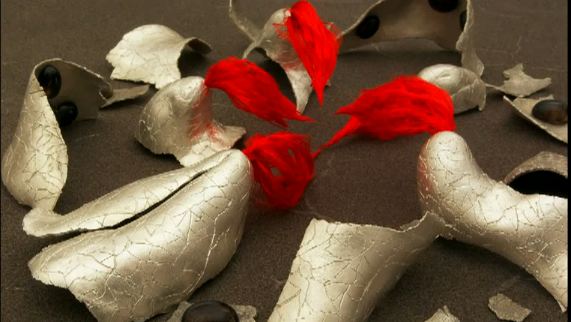“Seek” is a new international biennale consisting of hundreds of works of art, by 100 artists with widely varying approaches, styles and techniques.
On this level it works as an intriguing exploration of interesting work by unknown artists from across the world, selected by curators Calinda Salazar and Fletcher Ramsey.
The surprise comes when you realise that they all work together as a single artistic statement, skillfully created and curated by a one artist, with plenty of warm wit and humour for good measure.
The artist, Shea Hembrey, (born 1974) grew up in rural Hickory Grove, Arkansas in a family of farmers, factory workers, hunters, trappers, musicians, and cockfighters.
His interest in nature and an early fascination with birds (as a teenager he was a licensed breeder of migratory waterfowl) led his explorations as an artist on a journey to try to appreciate the influence of nature on humans and to understand how they have learnt from it and appropriated its forms for their own development.
Folk and Faith and Free Association
He has produced works on folk and faith healing inspired by his healer grandfather, and his view of art was profoundly changed while studying Maori art while he was a Rotary International Ambassadorial Scholar to New Zealand.
Hembrey focuses his concentration on a single project at a time allowing his research into the subject matter to direct the media and methods of the final product. His fascination with birds led to his exhibition “Mirror Nests”, a series of metal replicas of bird nests exhibited at Cornell University’s Lab of Ornithology observatory.
Exploring the self-obsession of modern art elitists, the visual language of different cultures, social stereotypes and the variety of methods artists choose to express themselves as individuals resulted in his current “Biennial” – “Seek: 100 in 2011—The Inaugural Exhibition”.
“I love contemporary art, but I am often frustrated at the contemporary art world and the contemporary art scene.”
After travelling around Europe to see the “major art exhibitions that have the pulse of what is supposed to be going on in the art world, I was struck by going to so many one after the other with some clarity of what it was that I was longing for.”
“Two of the main things: I was longing for more work that was appealing to a broad public, that was accessible, and the second thing was: more exquisite craftsmanship and technique.”
The Mimov Test and the Three H’s
After considering what the ingredients would be that he thought would make a perfect Biennale, “I decided: I’m going to start my own biennale. I’m going to start it and direct it and get it going in the world… I have to have some criteria of how to choose work.
Amongst all the criteria I have there are two main things, one of them I call my Mimov Test – I imagine explaining a work of art to my grandmother in five minutes, and if I can’t explain it in five minutes then it’s too obtuse or esoteric and it hasn’t been refined enough yet, it needs to be worked on until it can speak fluently.”
“My second set of criteria would be the three H’s, which is : Head, Heart and Hands. Great art would have Head; it would have interesting intellectual ideas and concepts. It would have Heart in that it would have passion and heart and soul, and it would have Hand in that it would be greatly crafted.”



